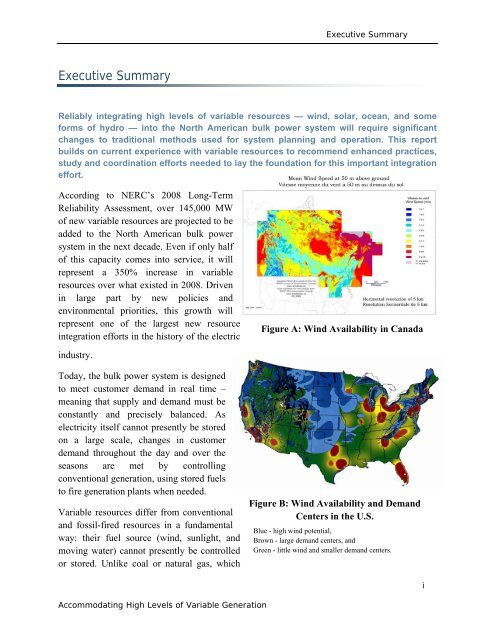Accommodating High Levels of Variable Generation - NERC
Accommodating High Levels of Variable Generation - NERC
Accommodating High Levels of Variable Generation - NERC
You also want an ePaper? Increase the reach of your titles
YUMPU automatically turns print PDFs into web optimized ePapers that Google loves.
Executive Summary<br />
Executive Summary<br />
Reliably integrating high levels <strong>of</strong> variable resources — wind, solar, ocean, and some<br />
forms <strong>of</strong> hydro — into the North American bulk power system will require significant<br />
changes to traditional methods used for system planning and operation. This report<br />
builds on current experience with variable resources to recommend enhanced practices,<br />
study and coordination efforts needed to lay the foundation for this important integration<br />
effort.<br />
According to <strong>NERC</strong>’s 2008 Long-Term<br />
Reliability Assessment, over 145,000 MW<br />
<strong>of</strong> new variable resources are projected to be<br />
added to the North American bulk power<br />
system in the next decade. Even if only half<br />
<strong>of</strong> this capacity comes into service, it will<br />
represent a 350% increase in variable<br />
resources over what existed in 2008. Driven<br />
in large part by new policies and<br />
environmental priorities, this growth will<br />
represent one <strong>of</strong> the largest new resource<br />
integration efforts in the history <strong>of</strong> the electric<br />
Figure A: Wind Availability in Canada<br />
industry.<br />
Today, the bulk power system is designed<br />
to meet customer demand in real time –<br />
meaning that supply and demand must be<br />
constantly and precisely balanced. As<br />
electricity itself cannot presently be stored<br />
on a large scale, changes in customer<br />
demand throughout the day and over the<br />
seasons are met by controlling<br />
conventional generation, using stored fuels<br />
to fire generation plants when needed.<br />
<strong>Variable</strong> resources differ from conventional<br />
and fossil-fired resources in a fundamental<br />
way: their fuel source (wind, sunlight, and<br />
moving water) cannot presently be controlled<br />
or stored. Unlike coal or natural gas, which<br />
Figure B: Wind Availability and Demand<br />
Centers in the U.S.<br />
Blue - high wind potential,<br />
Brown - large demand centers, and<br />
Green - little wind and smaller demand centers.<br />
i<br />
<strong>Accommodating</strong> <strong>High</strong> <strong>Levels</strong> <strong>of</strong> <strong>Variable</strong> <strong>Generation</strong>
















